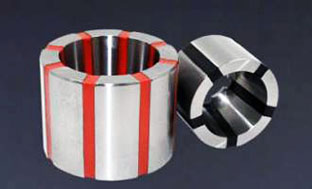Segmented Collet

Segmented collet is a mechanical component that achieves keyless connection between shafts and hubs through elastic deformation. It features high centering accuracy, high torque transmission capability, and convenient installation/removal, making it widely applicable in machine tools, gear processing, heavy machinery, and other fields24. Below is an analysis of its core characteristics and applications:
Basic Structure
· It belongs to the category of rotary shell components, with a corrugated deformation zone in the middle and straight walls of different outer diameters at both ends, generating clamping force through tapered angles.
· High-strength bolts are used to tighten the inner and outer rings, creating friction between the shaft and hub to transmit loads without requiring keyway machining.
Technical Principle
· Under axial force, the expansion sleeve contracts inward and expands outward, tightly fitting the shaft and hub to transmit torque via friction.
· It can protect equipment by failing under overload conditions and supports multiple sleeves in series to enhance load capacity.
· High-Precision Positioning: Centering accuracy surpasses traditional key connections, making it suitable for precision machining scenarios.
· Easy Installation: No heating or pressurizing equipment is required; assembly is completed simply by tightening bolts.
· Longevity and Safety: Friction transmission minimizes wear due to no relative motion, and automatic disengagement protects equipment during overload.
· Wide Adaptability: Compatible with a broad range of tolerances and supports frequent disassembly and reuse.
Machine Tool Fixtures
· Used in turning and gear processing fixtures to improve centering accuracy and clamping efficiency.
· Case study: After retrofitting to an expansion sleeve-type lathe fixture, clamping stability significantly improved.
Heavy Machinery
· Replaces key connections for transmitting heavy loads, such as in mining equipment and wind turbine yaw systems.
Automation Equipment
· Products from brands like Germany's RINGFEDER are used in high-torque transmissions for CNC machine tools and packaging machinery.
· Finite Element Optimization: Traditional empirical designs often result in high defect rates; ANSYS and other software are needed to simulate stress and expansion relationships, optimizing safety factors (recommended expansion: 0.15mm).
· Material Selection: Commonly used alloys include 65Mn and 55Cr2, requiring a balance between elasticity and strength.
· Parameter Matching: Must meet rated torque, axial force, and radial force requirements, with calculations referencing industry standards.
· Typical Brands: Examples include Germany's RINGFEDER RfN series, while domestic manufacturers like Envision Industry offer customized solutions.